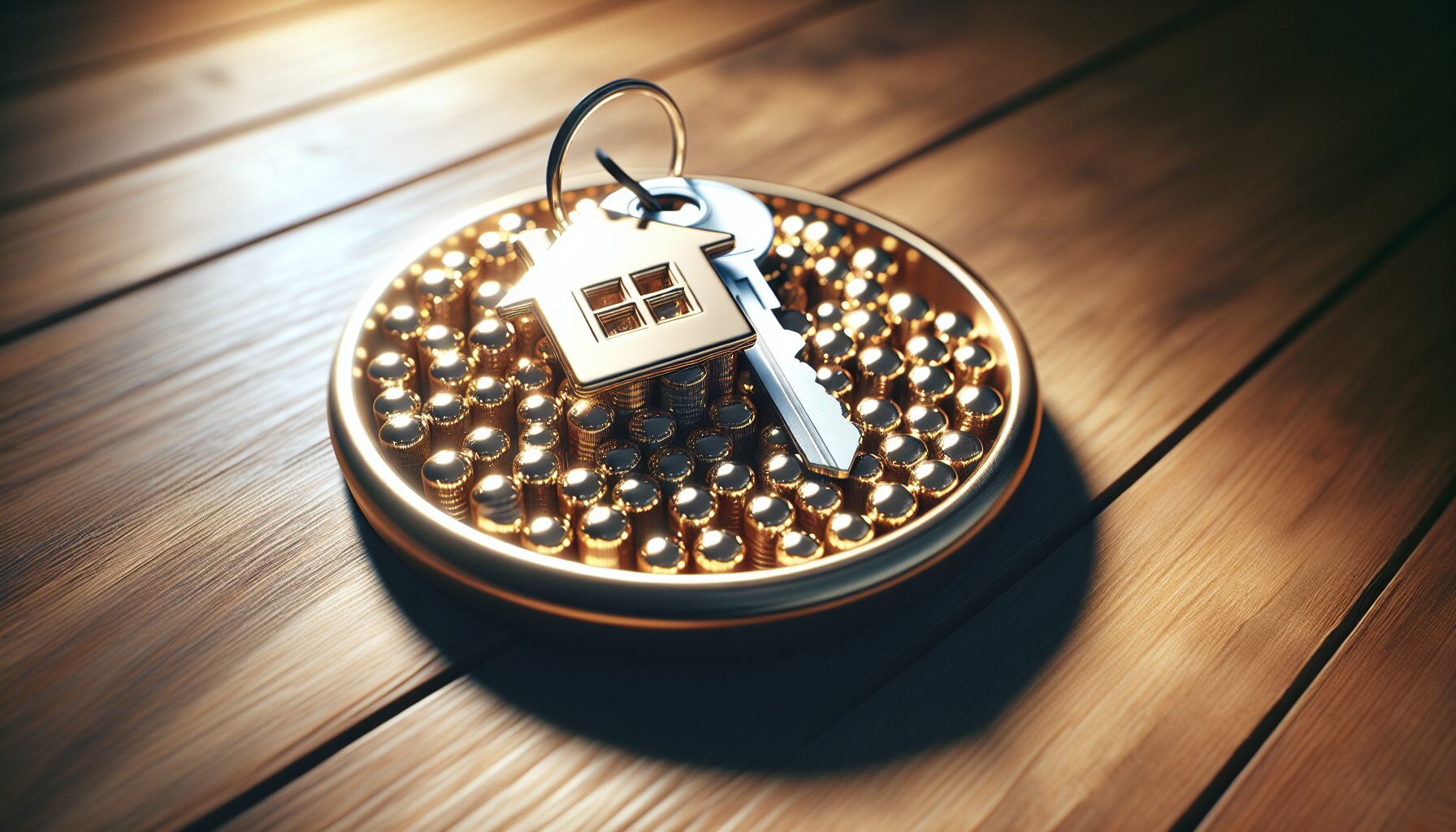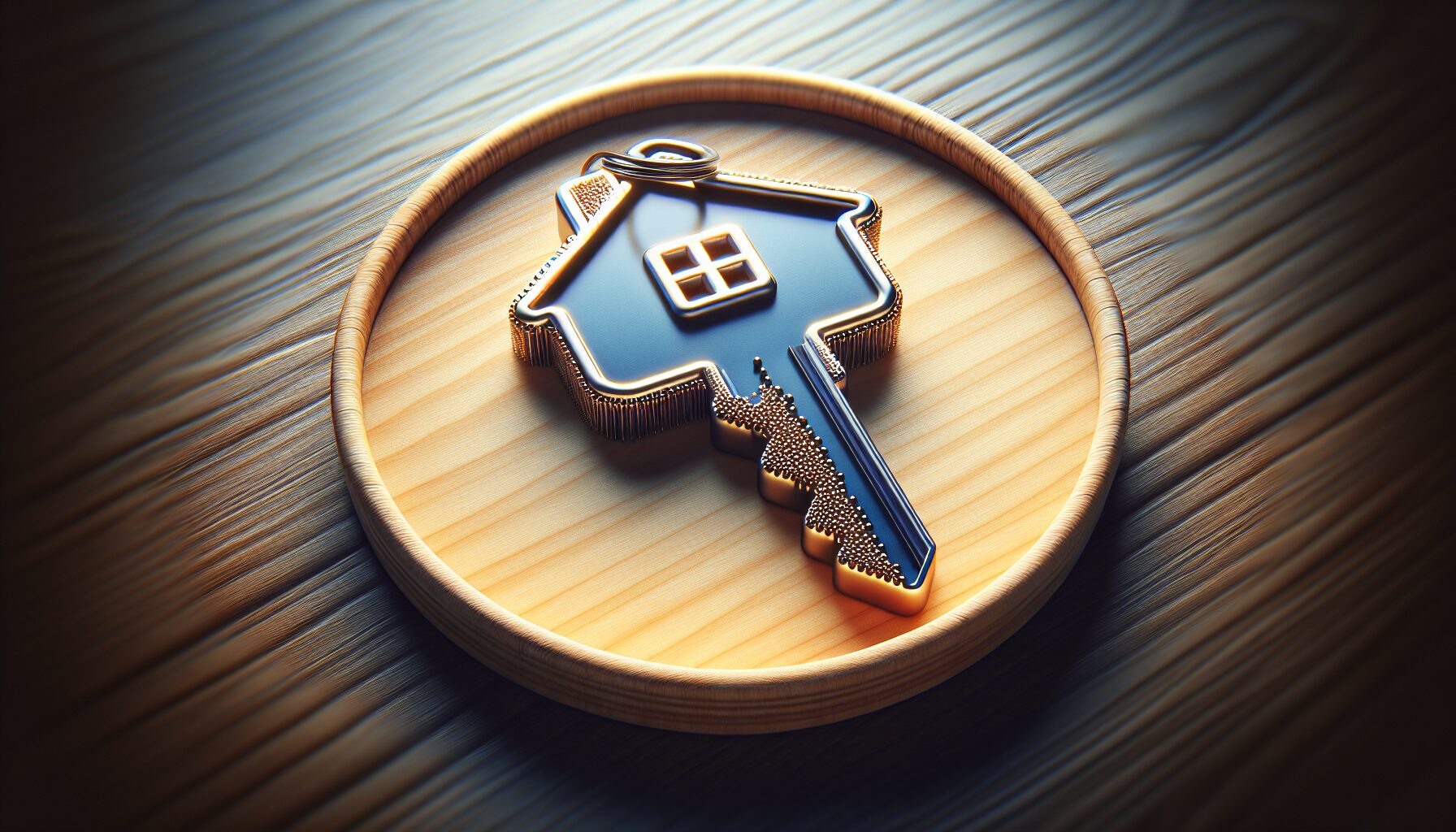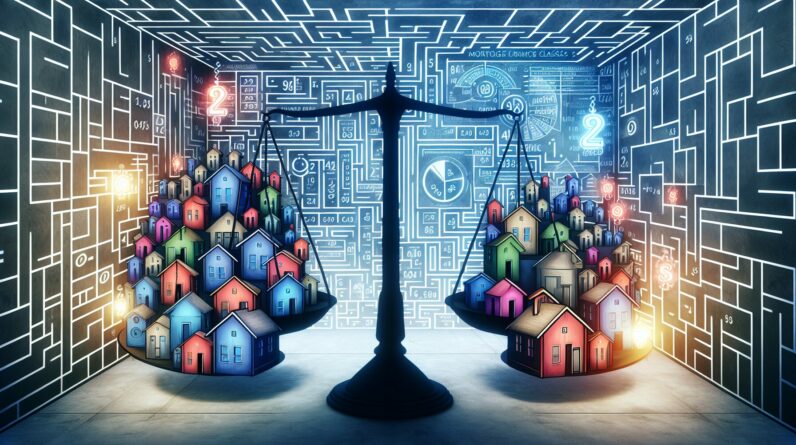
If you’ve been dreaming of owning your own home, you might be wondering what the easiest type of mortgage to get approved for is. Well, look no further! In this article, we will explore different types of mortgages and uncover which one could be your key to homeownership. Whether you’re a first-time buyer or have less-than-perfect credit, we’ve got you covered. So, get ready to uncover the secrets to finding the easiest mortgage to get approved for and take that important first step towards turning your homeownership dreams into reality.

Table of Contents
FHA Loan
Minimum credit score:
An FHA loan is a popular option for many first-time homebuyers because it has more lenient credit score requirements compared to other loan types. While conventional loans often require a credit score of 620 or higher, the minimum credit score requirement for an FHA loan is typically around 580. This means that even if you have had some past credit issues, such as late payments or collections, you may still be able to qualify for an FHA loan.
Low down payment:
One of the key advantages of an FHA loan is the low down payment requirement. With an FHA loan, you may be able to purchase a home with a down payment as low as 3.5% of the purchase price. This is significantly lower than the typical 20% down payment required for a conventional loan. A lower down payment can make homeownership more accessible and attainable for many borrowers, especially for those who may not have a large sum of money saved up.
Flexible income requirements:
Another benefit of an FHA loan is the flexibility it provides in terms of income requirements. While conventional loans often have strict debt-to-income ratios, the FHA loan program allows for a higher percentage of your income to go towards housing expenses. This means that even if you have a higher level of debt, you may still be eligible for an FHA loan if you meet the other requirements.
Higher interest rates:
It’s important to note that FHA loans typically have slightly higher interest rates compared to conventional loans. This is because FHA loans are insured by the Federal Housing Administration, which adds an extra layer of risk for lenders. However, the difference in interest rates is generally not significant enough to make a substantial impact on your monthly mortgage payment.
Mortgage insurance requirement:
One of the trade-offs of an FHA loan is the requirement for mortgage insurance. This is an additional cost that borrowers must pay to protect the lender in case of default. With an FHA loan, you are required to pay an upfront mortgage insurance premium, as well as an annual mortgage insurance premium that is included in your monthly mortgage payment. While this adds to the overall cost of the loan, it also allows borrowers to access homeownership with a lower down payment and credit score.
VA Loan
For military veterans:
A VA loan is a mortgage loan that is available exclusively to eligible military veterans and their spouses. This loan program is designed to help veterans achieve their dream of homeownership by offering favorable terms and benefits.
No down payment required:
One of the most attractive features of a VA loan is that it does not require a down payment. This means that eligible veterans can purchase a home without having to save up a large sum of money for a down payment. This can be a significant advantage, especially for those who may not have the financial means to make a substantial down payment.
Competitive interest rates:
VA loans typically offer competitive interest rates that are comparable to or even lower than conventional loans. This can help veterans save money over the life of their loan by lowering their monthly mortgage payments. The lower interest rates can also make homeownership more affordable for veterans and their families.
Flexible credit requirements:
While VA loans do have credit score requirements, they are generally more flexible compared to other loan types. This is because the Department of Veterans Affairs guarantees a portion of the loan, which reduces the risk for lenders. As a result, veterans with less-than-perfect credit can still qualify for a VA loan and enjoy the benefits of homeownership.
Funding fee:
One important thing to be aware of with VA loans is the funding fee. This is a one-time fee that is paid either upfront or rolled into the loan amount. The funding fee helps offset the cost of the VA loan program and allows it to remain self-sustaining. While the funding fee adds to the upfront cost of the loan, it can be financed into the loan, making it easier for veterans to afford.
USDA Loan
For rural homebuyers:
USDA loans are specifically designed for homebuyers in rural areas. These loans are offered through the United States Department of Agriculture (USDA) Rural Development program to help promote homeownership in rural communities.
No down payment required:
Similar to VA loans, USDA loans do not require a down payment. This is a significant benefit for rural homebuyers who may not have access to a large sum of money for a down payment. The ability to purchase a home without a down payment can make homeownership more achievable for those living in rural areas.
Low interest rates:
USDA loans often come with lower interest rates compared to conventional loans. This can result in significant savings over the life of the loan by reducing monthly mortgage payments. Lower interest rates make homeownership more affordable for rural homebuyers and can help stimulate economic growth in rural communities.
Flexible credit requirements:
USDA loans have more flexible credit requirements compared to conventional loans. While a good credit score is still important, USDA loans take into account other factors such as payment history, income stability, and debt-to-income ratio. This means that individuals with less-than-perfect credit may still be able to qualify for a USDA loan.
Income restrictions:
In order to qualify for a USDA loan, borrowers must meet certain income eligibility requirements. These requirements are based on the area’s median income and the number of individuals in the household. The goal of these income restrictions is to ensure that USDA loans are being used to help low- and moderate-income families in rural areas achieve homeownership.
Conventional 97 Loan
Low down payment:
The Conventional 97 loan is a mortgage loan that offers a low down payment option for borrowers. With this loan program, you may be able to purchase a home with as little as 3% down. This is lower than the standard 5% down payment required for conventional loans, making homeownership more accessible for those who may not have a large amount of savings.
Flexible credit requirements:
While Conventional 97 loans do have credit score requirements, they are generally more flexible compared to other conventional loans. A credit score of 620 or higher is typically needed to qualify for a Conventional 97 loan. However, lenders may also consider other factors such as your payment history and debt-to-income ratio when evaluating your loan application.
No upfront mortgage insurance:
One of the advantages of the Conventional 97 loan is that it does not require upfront mortgage insurance. This can save borrowers a significant amount of money at the time of closing. Unlike FHA loans, which require both an upfront and annual mortgage insurance premium, the Conventional 97 loan only requires an annual mortgage insurance premium.
Higher interest rates:
It’s important to note that Conventional 97 loans typically have slightly higher interest rates compared to other conventional loans. This is because the lower down payment may be perceived as a higher risk for the lender. However, the difference in interest rates is generally not significant enough to make a substantial impact on your monthly mortgage payment.
Private mortgage insurance requirement:
Although the Conventional 97 loan does not require upfront mortgage insurance, it does require private mortgage insurance (PMI). PMI is an additional cost that borrowers must pay to protect the lender in case of default. The cost of PMI varies based on factors such as the loan amount, down payment, and credit score. However, it is important to consider the cost of PMI when determining the overall affordability of the loan.

Conventional Loan
Higher credit score required:
Conventional loans typically have higher credit score requirements compared to other loan types. While some lenders may offer conventional loans to borrowers with credit scores as low as 620, a higher credit score, typically 680 or above, is often required to qualify for the best interest rates and terms. A higher credit score demonstrates to lenders that you are a lower credit risk and are more likely to make your mortgage payments on time.
Minimum down payment required:
Unlike some government-backed loans that offer low or no down payment options, conventional loans generally require a minimum down payment. The specific down payment requirement can vary depending on factors such as your credit score, income, and the type of property you are purchasing. Typically, a down payment of at least 3% to 5% of the purchase price is required for a conventional loan.
Competitive interest rates:
One of the advantages of a conventional loan is the potential for competitive interest rates. Conventional loans are not backed by a government agency like FHA or VA loans, which means lenders have more flexibility in setting interest rates. This can be beneficial for borrowers who have excellent credit and are looking to secure a loan with a lower interest rate.
Flexible loan terms:
Conventional loans offer a wide range of loan terms, allowing borrowers to choose a repayment plan that best suits their financial goals. With conventional loans, you can typically choose between 15-year and 30-year loan terms, depending on your preference and financial capabilities. This flexibility can make it easier to budget for your monthly mortgage payments and pay off your loan in a timeframe that works for you.
Possibility of private mortgage insurance:
Depending on the down payment amount and credit score, conventional loans may require private mortgage insurance (PMI). PMI is an additional cost that borrowers must pay to protect the lender in case of default. The cost of PMI varies based on factors such as the loan amount, down payment, and credit score. It’s important to consider the cost of PMI when deciding between a conventional loan and other loan options.
HomeReady Loan
Minimum credit score:
The HomeReady loan is a mortgage program designed to help low- to moderate-income borrowers achieve homeownership. While there is no specific minimum credit score requirement for a HomeReady loan, borrowers typically need a credit score of at least 620 to qualify. However, lenders may consider other factors such as income stability, debt-to-income ratio, and payment history when evaluating your loan application.
Low down payment:
One of the key benefits of a HomeReady loan is the low down payment option. With a HomeReady loan, you may be able to purchase a home with a down payment as low as 3% of the purchase price. This can make homeownership more attainable for borrowers who may not have a large amount of savings.
Flexible income requirements:
HomeReady loans are designed to help borrowers with low- to moderate-income levels. The program offers flexible income requirements, which means that individuals with varying income levels may still be eligible for a HomeReady loan. Additionally, income from non-borrower household members, such as parents or siblings, may be considered when determining eligibility.
Competitive interest rates:
HomeReady loans typically offer competitive interest rates, making homeownership more affordable for eligible borrowers. The exact interest rate you qualify for will depend on factors such as your credit score, income, and loan amount. It’s important to shop around and compare offers from different lenders to ensure you are getting the best rate possible.
Mortgage insurance requirement:
Similar to other low down payment loan programs, HomeReady loans require borrowers to pay mortgage insurance. Mortgage insurance helps protect the lender in case of default. The cost of mortgage insurance can vary based on factors such as the loan amount, down payment, and credit score. It’s important to include the cost of mortgage insurance when calculating your overall homeownership costs.

HomePossible Loan
Low down payment:
The HomePossible loan is designed to help low- to moderate-income borrowers achieve their dream of homeownership. One of the main benefits of a HomePossible loan is the low down payment option. With a HomePossible loan, you may be able to purchase a home with a down payment as low as 3% of the purchase price. This can make homeownership more accessible for individuals who may not have a significant amount of savings.
Flexible income requirements:
HomePossible loans offer flexible income requirements, allowing borrowers with varying income levels to qualify for the program. In addition to considering your own income, lenders may also take into account income from non-borrower household members, such as parents or siblings, when evaluating your loan application. This can be especially beneficial for borrowers who have other sources of income that may not be considered in traditional loan programs.
Competitive interest rates:
HomePossible loans typically offer competitive interest rates, making homeownership more affordable for eligible borrowers. The specific interest rate you qualify for will depend on factors such as your credit score, income, and loan amount. It’s important to compare offers from different lenders to ensure you are getting the best rate possible.
Private mortgage insurance requirement:
Similar to other low down payment loan programs, HomePossible loans require borrowers to pay private mortgage insurance (PMI). PMI is an additional cost that borrowers must pay to protect the lender in case of default. The cost of PMI can vary based on factors such as the loan amount, down payment, and credit score. It’s important to consider the cost of PMI when determining the overall affordability of the loan.
Multiple occupancy options:
HomePossible loans offer flexibility when it comes to occupancy. Borrowers can choose to use the loan for a primary residence, a second home, or an investment property. This can be particularly beneficial for individuals who want to buy a property as an investment or have the option to use it as a vacation home in the future.
Adjustable-rate Mortgage (ARM)
Lower initial interest rate:
An adjustable-rate mortgage (ARM) is a type of loan where the interest rate is variable and can change over time. One of the main advantages of an ARM is the lower initial interest rate compared to fixed-rate mortgages. This can result in lower monthly mortgage payments during the initial fixed-rate period, making homeownership more affordable in the early years of the loan.
Adjusts over time:
With an ARM, the interest rate can adjust periodically based on changes in a reference interest rate, such as the prime rate or the London Interbank Offered Rate (LIBOR). The adjustments typically occur after an initial fixed-rate period, which can range from three to ten years. After the initial period, the interest rate may adjust annually or as frequently as once a month, depending on the terms of the loan.
Potential for higher monthly payments:
One important thing to consider with an ARM is the potential for higher monthly payments in the future. When the interest rate adjusts, your monthly mortgage payment may increase, which can put a strain on your budget. It’s important to carefully consider your financial situation and future plans when deciding whether an ARM is the right choice for you.
Shorter initial fixed-rate period:
Unlike a traditional fixed-rate mortgage, which offers a set interest rate for the entire term of the loan, an ARM has an initial fixed-rate period followed by an adjustable period. The length of the initial fixed-rate period can vary, but it is typically shorter than the full term of the loan. This shorter fixed-rate period can be advantageous for borrowers who plan to sell the property or refinance before the adjustable period begins.

Interest-only Mortgage
Lower monthly payments initially:
An interest-only mortgage is a type of loan where the borrower only pays the interest on the loan for a specific period, typically between five and ten years. During this initial period, the monthly payments are lower compared to a traditional mortgage, which includes both principal and interest payments. This can make homeownership more affordable, especially for borrowers who are looking for temporary payment relief.
Interest-only payments for a set term:
With an interest-only mortgage, the borrower is only required to make interest payments for a predetermined period, usually between five and ten years. After this initial period, the loan typically converts to a traditional mortgage, where the borrower must start making principal and interest payments. It’s important to plan ahead and budget for the increase in monthly payments once the interest-only period ends.
Principal balance remains the same:
During the interest-only period of the loan, the borrower’s monthly payments go towards the interest charges only. This means that the principal balance of the loan remains the same. It’s important to note that the borrower will still owe the full amount of the loan at the end of the interest-only period, unless they choose to make additional principal payments.
Higher risk for borrowers:
While interest-only mortgages can provide temporary payment relief, they come with higher risks for borrowers. Since the principal balance remains the same during the interest-only period, there is no equity build-up in the property. This means that if the property’s value decreases or the borrower is unable to refinance or sell the property, they may be left with a mortgage that is greater than the property’s value.
Higher interest rates:
Interest-only mortgages typically come with higher interest rates compared to traditional mortgages. This is because lenders view these loans as riskier due to the delayed principal repayment. It’s important to carefully consider the long-term financial implications of an interest-only mortgage and compare it to other loan options to ensure it aligns with your financial goals.
Jumbo Loan
Higher loan amount:
A jumbo loan, also known as a non-conforming loan, is a mortgage loan that exceeds the conforming loan limits set by Fannie Mae and Freddie Mac. These loan limits vary by location but are generally set higher than the limits for conventional loans. The ability to borrow a higher amount can be beneficial for borrowers who are looking to purchase a high-value property.
High credit score required:
Due to the larger loan amounts, lenders typically require a higher credit score for jumbo loans compared to conventional loans. A good credit score demonstrates to lenders that you are a lower credit risk and are more likely to make your mortgage payments on time. While the specific credit score requirement can vary, a score of 700 or above is generally recommended for jumbo loan eligibility.
Large down payment required:
Jumbo loans often require a larger down payment compared to conventional loans. The exact down payment requirement can vary depending on factors such as the loan amount and the borrower’s financial situation. Typically, a down payment of at least 20% of the purchase price is required for a jumbo loan. This higher down payment helps offset the increased risk associated with larger loan amounts.
Strict income requirements:
Jumbo loans have stricter income requirements compared to conventional loans. Lenders typically require borrowers to have a stable source of income and a low debt-to-income ratio. This is because the higher loan amounts carry a higher risk for lenders, and they want to ensure that borrowers have the financial means to make their mortgage payments.
Higher interest rates:
Since jumbo loans carry higher loan amounts and are considered riskier by lenders, they often come with higher interest rates compared to conventional loans. It’s important to carefully consider the long-term cost of a jumbo loan and assess your ability to make the higher monthly mortgage payments. Shopping around and comparing offers from different lenders can help you find the best interest rate for your jumbo loan.
In conclusion, there are various types of mortgage loans available, each with its own set of advantages and requirements. The best type of mortgage for you will depend on your specific financial situation, credit history, and homeownership goals. It is important to carefully evaluate your options and compare offers from different lenders to find the loan that best meets your needs. Whether you are a first-time homebuyer, a military veteran, or looking to purchase a property in a rural area, there is likely a loan program that can help you achieve your dream of homeownership. Remember to consult with a mortgage professional to guide you through the process and determine the easiest type of mortgage to get approved for in your specific circumstances.








